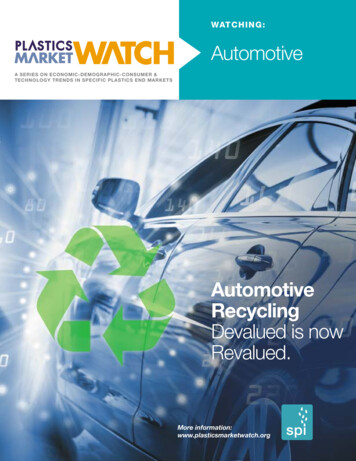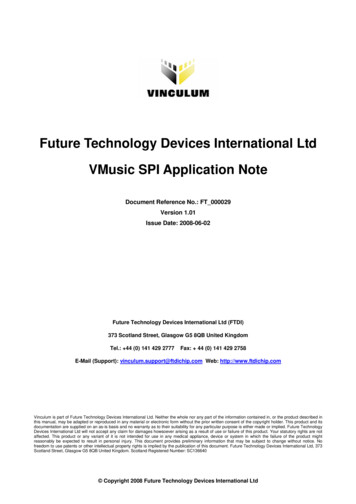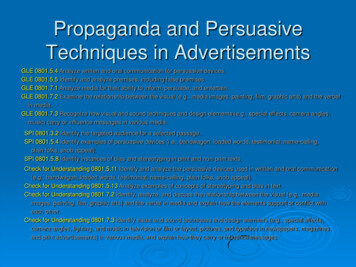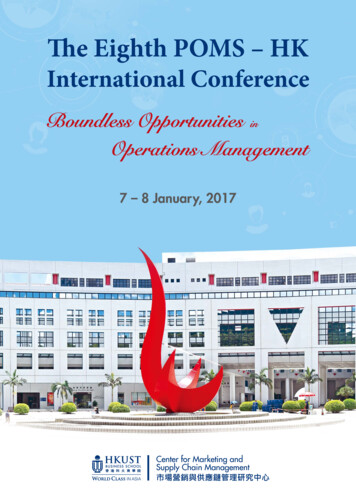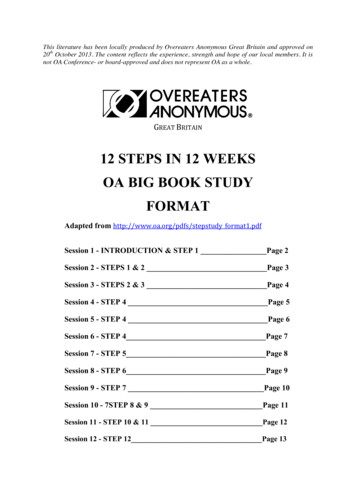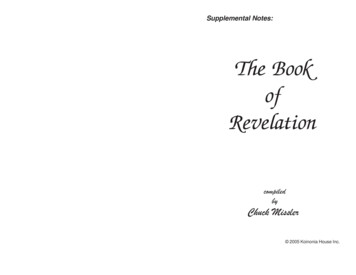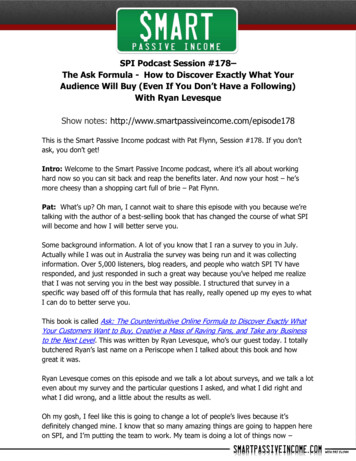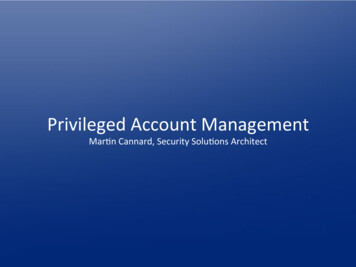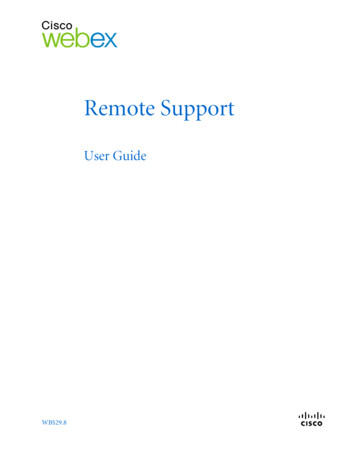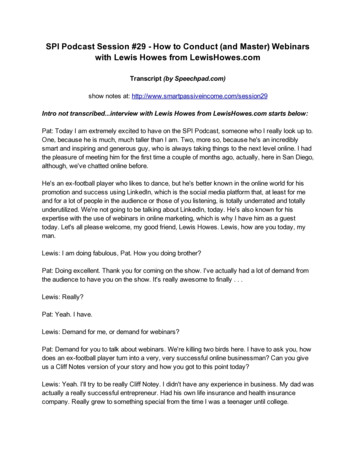
Transcription
SPI Podcast Session #29 - How to Conduct (and Master) Webinarswith Lewis Howes from LewisHowes.comTranscript (by Speechpad.com)show notes at: http://www.smartpassiveincome.com/session29Intro not transcribed.interview with Lewis Howes from LewisHowes.com starts below:Pat: Today I am extremely excited to have on the SPI Podcast, someone who I really look up to.One, because he is much, much taller than I am. Two, more so, because he's an incrediblysmart and inspiring and generous guy, who is always taking things to the next level online. I hadthe pleasure of meeting him for the first time a couple of months ago, actually, here in San Diego,although, we've chatted online before.He's an ex-football player who likes to dance, but he's better known in the online world for hispromotion and success using LinkedIn, which is the social media platform that, at least for meand for a lot of people in the audience or those of you listening, is totally underrated and totallyunderutilized. We're not going to be talking about LinkedIn, today. He's also known for hisexpertise with the use of webinars in online marketing, which is why I have him as a guesttoday. Let's all please welcome, my good friend, Lewis Howes. Lewis, how are you today, myman.Lewis: I am doing fabulous, Pat. How you doing brother?Pat: Doing excellent. Thank you for coming on the show. I've actually had a lot of demand fromthe audience to have you on the show. It's really awesome to finally . . .Lewis: Really?Pat: Yeah. I have.Lewis: Demand for me, or demand for webinars?Pat: Demand for you to talk about webinars. We're killing two birds here. I have to ask you, howdoes an ex-football player turn into a very, very successful online businessman? Can you giveus a Cliff Notes version of your story and how you got to this point today?Lewis: Yeah. I'll try to be really Cliff Notey. I didn't have any experience in business. My dad wasactually a really successful entrepreneur. Had his own life insurance and health insurancecompany. Really grew to something special from the time I was a teenager until college.
Before that, we didn't have any money. I would always try to figure out how was I going to makemoney as and adult. I didn't want to work for anyone, so I never worked a real job. I had someinternships. I was a bouncer at a night club. I was a truck driver in between college footballseason and professional football season. I knew I hated it whenever I was working for someoneelse. I had no clue how to build a business.What my dad had learned, I never learned. How he learned to become an entrepreneur, henever taught that to me because I was so focused on one thing in my life, and that was mypassion, which was being a professional athlete. I put all of my energy during college and aftercollege to training; visualization about my success as an athlete; getting bigger, faster, stronger;networking with players and coaches; doing whatever I could to achieve the one goal that Iwanted to achieve.After my rookie season, I got injured. I had to have surgery. I was recovering for about 6 to 12months from this surgery that I had. During that time, I was trying to figure out what is my nextstep. I couldn't play football anymore. I had to retire because of this injury and this surgery. Myentire passion, my entire dream, my entire focus that I had my whole childhood was now gone. Ihad no back-up plan.I went to college, basically, just to play sports. I barely passed with a 2.0 average, probably. Ihardly went to class. I didn't try, because I knew exactly what I wanted. I had a passion and adrive and I put 100% of it into this one thing of playing sports. There was a couple of things thathappened. I'm going to try and shorten this down. I know I'm speaking too long here.Pat: No, no. Take your time. This is all good stuff.Lewis: There were a couple things that happened. I knew I was so ignorant when it came tobuilding a business. I had zero experience. I didn't go to school for this. I went to school forsports management. I knew I was extremely competitive. If I wanted to achieve something, Icould achieve it. Based on my sports background and the great coaches that I had, I learned alot on how to apply certain principles to anything, not just sports.I figured out a way to apply it to the business world. I knew I didn't want to get a job. There werea couple of moments where I almost went to go for interviews, eventually, because I was sobroke. I was sleeping on my sister's couch for the first six months after I got injured, and again, Iwas trying to figure out what my next calling was going to be. I started researching. I had a lot offree time because I was in a cast recovering. I spent a lot of this time initially on LinkedIn, abouteight hours a day, building a network on LinkedIn, connecting with people one-on-one, askingsuccessful people I saw on LinkedIn how they got to where they are right now.I would find successful authors, CEOs, Entrepreneurs. I would reach out to them and literallyask them questions about their success. I learned early on not to ask them advice about how Icould get a job or do something, because no one wants to give advice, but they're willing to talk
about their successes.For me, I started doing that and building a very large network, around 35,000 people in the first12 to 15 months, an email list I built using LinkedIn. Again, I had about six to eight hours a day Iwas doing this.I also started researching about online marketing, persuasion, influence, email marketing, socialmedia marketing, and just dabbling in this, basically, 24/7 for the first year after my surgery. Iwas still not sure how I was going to make money or build a business.I eventually, slowly started hosting events, then wrote a book, started doing some one-on-onestuff, started very small, getting paid 50 for an hour and then moving it up to 100, and thenincreasing it. I think over time I learned how to grow it, based off of my passion from sports, andbeing able to apply that to the business world. I guess that's my Cliff Notes version.Pat: Thanks. I apologize about the injury. I know that was totally life- changing, and probablyvery drastic for you when it was happening, but it turned out to be okay, because you have adetermination and everything you applied in sports you were able to apply in life as well. Whatwere some of the one or two things that you learned in sports that you applied to get to whereyou're at today?Lewis: I think the more and more I hang out in the business world I try to surround myself withmuch smarter people than myself. It's not that hard to do, because I'm extremely ignorant. Prettymuch a lot of the people that I hang out with are much smarter than me, but one of the things I'vefigured out is, as I've grown, early on I saw people that I thought were really successful whowere doing big things, or doing something online, creating products, I started to outgrow wherethey were at after a year or two, and realized that they lacked something that I would say I don'tlack.They maybe were a lot smarter than me in a lot of ways, much more book smart, have a lot ofexperience, understand the business world and practices and systems much better than I do,but I think a lot of it is just drive. I don't know if there's a specific word for it, but I was sopassionate about being the best that I could be as an athlete. I had the willingness to sacrificewhatever it took, ethically, to get to where I wanted to be.I think a lot of people in the business world, or online marketing world, or whatever it may be,they have that same drive and that passion to be successful, or to achieve some goal they mayhave, but they don't have the willingness to sacrifice whatever it takes, ethically, to achieve thatgoal they have.For me, it's all about being the best in the world at what I do. I'm willing to sacrifice not having agirlfriend, not going on a trip, or sleeping on my sister's couch for a year to figure it out, asopposed to taking a job and taking the easy way out. I'm willing to spend all day and all night
working if I need to get something done. I'm willing to stay up all night. I'm willing to do whateverit takes to go out of my way to meet the right people, and offer value to them. I'm willing to dothese things. I think some people make excuses and are just not willing to sacrifice the sameway I am.Pat: No, totally understandable. There are a couple of things I want to mention. First, your wholeidea about making connections with people, I think that's absolutely important. Nobody can doany of this business stuff alone. You have to make connections. You have to build relationships,and like you said, build relationships with people that are a lot smarter than you. I know a lot ofpeople are a lot smarter than me too. And how I got started with doing business online was justby going around and seeing what inspired me, what other people were doing, and justconnecting with them. Sometimes it's as easy as just asking them, just like you did, how did youget to where you're at, and just learning as much as I can.The second thing that you touched on was, we've heard this term before, Gary Vaynerchukuses it, is crushing it and really putting all you have into what you want to do. We all want to bethe best at what we do, but for some reason there are a lot of things that hold us back. We settlewith being second best, or third best, or tenth best, or whatever. I think that you're a perfectexample of somebody who really knows that you have to try to be the best, and to do whatever ittakes to get there. That's a great story.So you went from ex-football player to making all these connections on LinkedIn, which I think isinteresting. And that itself can be another webinar all in itself. So how did you take thoseconnections on LinkedIn and turn that into a business? Also talk about what is your business,what are selling or how are you making money?Lewis: So I'll answer the first question, how did I start generating business using LinkedInconnections? Originally, I just had this big audience of 30,000 to 40,000 people in the first year,year and a half, and I wasn't sure what to do with it because I had no clue how to money or howto get a transaction.I initially started to, I said, "You know what, I'm meeting all these great people on LinkedIn andI'm connecting with them via email and on the phone, but they're not connecting with each other,the people I'm meeting." So I said, "I would love to bring these people together for online, offline."They could probably leverage each other's relationships, do business together, help each otherwith referrals.In 2008, when this was all happening, the economy was pretty bad, so I was like, "How can Ihelp people grow their business." So I hosted about 20 live LinkedIn networking events aroundthe country where I would get around 300 to 500 people to show up. They're about three to fourhours long, just at a restaurant or a bar, and I started hosting them for free. People loved them.They were meeting other people in their city; they were doing business; it was great. And I wasthe one hosting the event so it automatically put me up on another level as an authority, I guess.
People wanted to talk to me now as opposed to me reaching out to them.I remember this specifically, I said, "Wow." The first one I had, 350 people show up, it was a freeevent. I got 1,000 from sponsors. I had four tables at 250 a pop, or five tables or somethingthat I'd sold, so I made about a grand, I broke even from all the work I put into it. I said, "I wonderif I can charge people at the door and we'll still get the same amount of people to show up."So I charged 5 at the next event, or it was one of the next events, I charged 5, and I wasscared that no one was going to show up. We had more people show up at that event than theprevious event and it cut out the bottom feeders, the people who were just there for themselvesand not willing to give. So I said, "I wonder if I can charge even more?" So I kept increasing theprice from 5 to 10 to 20 and more and more people started coming and more people paidbigger dollars for sponsorships.I started asking the restaurant, the places that I would host them, I would say, "I'm going to bringyou 300 to 500 people, but I'd 10% to 15% of food and bar sales." So I started leveraginganyway I could to generate some income. I was taking from the door; I was taking from thesponsorships and food and bar sales. I was making a few grand in cash when I'd do this. So forme, I started making a little bit of money. I was like, "You know what, this is still chump changeand I'm scrapping around every month just promoting events, but I'm not really leveragingsomething with passive income." You can appreciate this.I started also doing one-on-one consulting where I was charging 50 and eventually up to 300 asession for LinkedIn profile makeovers. But again, I was trading my time for dollars, and I didn'twant to do that. It wasn't passive. So my friends suggested that I write a book about it and getmy information out there so I could sell it to the masses. So that's what I did, but I still wasn'tmaking any money after I wrote this book. I was making some sales, but it was doing somethingdifferent for me, it was giving me a platform to speak and do that.Pat: Was this an e-book or a book you can actually . . .Lewis: This is a physical paperback book.Pat: Very cool.Lewis: It's up on Amazon and up on BarnesandNoble.com, things like that. And I said, "How canI leverage this same information from a 15 book, but generate a real business from this so I'mnot scrapping around every month trying to make a few thousand dollars." It wasn't until my firstwebinar, a friend of mine named Joel Comm said, "I want you to come on and present on awebinar." I'd never even heard of what a webinar was at the time, this is in 2009.He said, "Come on and do a webinar. I want you to share the exact same content that's in yourLinkenIn book. Break it up, you need to create some slides, share some of the content, talk
about how people can leverage it to build their business or get some more leads. And then atthen end, I want you to have some type of training or a product you have, and I'm going to take acommission based on the sales you get from this live webinar."I had no clue what he was talking about. I didn't know about affiliate marketing, I had never beenon a webinar, I barely knew how to open up PowerPoint. I didn't know how to create a product,let alone a sales page and hook it up with a shopping cart and merchant account. I was soclueless and really scared about what I was doing.Luckily, I had some good friends who had created sales pages, so I had a friend create a reallyjanky looking sales page last minute, connect it to one shopping cart, and just made sureeverything worked when people clicked the checkout button. I didn't have a product because Ididn't know what I was doing. So what I said is, "I'm going to create a live training for threeweeks. I'll do two hours a day, once a day for three weeks, or excuse me, once a week for threeweeks in a row and I'll charge 150." So I did this, not knowing what was going to happen. I gavemy speech over the webinar. There were around 600 people on. I was sweating bullets.I was staying at my brother's house at the time, so I went from my sister's couch to renting aroom from my brother's place for 250 a month, which was a lot of money for me at the time. Iremember being in his foyer area, it was a hot summer day, I had to take my shirt off because Iwas sweating and so nervous about this Webinar. I was so scared to talk in front of people. Iwas sweating, shirtless, the Webinar starts. I put these slides together last minute, it was sojanky looking and unprofessional.The first 15 minutes my voice was trembling and shaking as Joel was introducing me and I'mtrying to get into the content. Eventually I get right into my information about LinkedIn and I startto hit my stride on the webinar. I give some great points. I know my content so once I startedtalking about it; it was good and people loved it. At the end of the webinar, I'm basically like,okay, guys, here's a link. I've got this cool training that I'm going to create. It's not even startinguntil next week, but go check it out if you want to and you can see the price on the sales page orwhatever and I was like I hope you guys enjoyed it.Joel was like, "Wait a minute, let's go over exactly what this is. This is some great information.People were blown away on this live webinar." So he broke it down for everyone what thetraining actually was and kind of helped me sell it. I was so nervous. I wasn't sure the webinarwas done. We basically closed it down, but I didn't want to close the screen down, I was scaredI was going to break something or somebody was going to hear me. I eventually waited until hehad ended the webinar.I opened up my Gmail account. The only thing I saw was, you've got money, and it was synchedup through my PayPal at the time so I think that's what it says, you've got money whensomeone sends you money. My entire email account was filled out because I think I show 50results, so the top 50 it said, you've got payment or you've got money or whatever it said and I
started freaking out, because I realized I just made that many sales where my entire Gmail onmy screen all I could see was, you've got payment. I basically made 6300 after one hour.For me, going from scrapping around and not knowing how to generate any money and hostingthese events and doing all this stuff, one-on-one stuff I was like wow. If I can transfer all myinformation into leveraging it for a larger audience like this, then I could really build a significantbusiness. At the time going from sleeping on my sister's couch to paying 250 rent a room at mybrother's place for a year to this happening, 6300 in an hour, it was life-changing for me. It reallyflipped the switch for me where I said I could get on one of these every single day and do anhour of this every day.I said if I can make 6300 every day, I can do this all the time. It got to the point where for thelast two years I've basically done a webinar, I do a lot of them. I've done over 500 Webinars overthe last couple years. Now if I do 6,300 on a webinar it's a very bad day and I'm depressed, soI've learned to leverage the information and package things over the last couple of years to reallybuild a significant business now for myself.Pat: That's incredible. So what kind of figures are you seeing now when you do a webinar? Howmany people attend and how much can you expect?Lewis: It all depends on the product. I've got a number of different products now. That was myfirst product, I've got like seven or eight now, different price points from 100 to 1000 and evenhigher for different coaching programs we have and live events. It all depends, but we usually tryto get 500 to 1,000 people on every webinar that we host and that's pretty standard for us anddepending on the price point we pretty much know the conversion rate we're going to getdepending on the price point.For the 100 course or training or service or product, it's usually around 25% to 40%conversion. If it's a 500 course, it's usually around 12% to 18%, and if it's 1000 or above, ifwe're getting 8% to 15% depending on the audience and the product and the offering is wherewe're at.Pat: That's huge. Some significant money now coming from webinars and this is kind of yourideal platform to do business on now.Lewis: Yeah, I'm a huge believer in webinars and I just think they're amazing because they do acouple of things for you. You don't have to travel anywhere. You just spoke recently at BlogWorld and you had a great time. You said it was one of the biggest attended at the event and yousaid you wanted to get into it more because it's fun.You get to speak in front of an audience. They get to understand who you are. They see you.They hear you. There's an experience around it. They know, like and trust you more and they'reprobably more willing to be your fan or buy from you in the future after they hear from you. But
you can't travel around. You told me also that it took you two weeks to recover.Pat: I'm still recovering.Lewis: You're just now recovered from after live events. It took you a lot of time. On a webinaryou could do three to four of those a day, or you could automate webinars and do much morethan that. For me, I can do a couple webinars a day and be out for maybe two hours afterwardswhere I just want to relax because I've been speaking for a few hours during the day, but I cansee significant results because I'm able to reach a much larger audience from all over the world.On webinars you really are able to connect with your audience or an unknown audience muchbetter, by giving them great value, great content and really just introducing them to you a lotbetter. When people can connect to you in that format, it's amazing and you can generate a lotfrom it.Pat: I've heard that webinars is the closest thing to actually being with a person in real life. Theother cool thing about it is you can do this from anywhere. You can be mobile. You can betraveling. You can still do a webinar if you just have online access. The other cool thing is thatanybody anywhere in the world can watch you. They don't have to travel either to come watchyou and be with you and hear you out.Now you explained that when Joel Comm contacted you he said okay come on my webinar, andyou had no idea really what that meant. Let's get into the content of what a webinar is and kind ofhow to go into the details and we'll talk about the software and different things like that. Howwould you answer the question to a total beginner who doesn't know anything about what awebinar is, what is a webinar?Lewis: Sure. It's a live seminar but just based online. So opposed to being in a room withsomeone where there's a speaker on stage, you're at your laptop and you're hearing thespeaker present their slideshow or their video live to you. So you can be anywhere in the world,they can be anywhere in the world and it's just like a seminar over the Internet.Pat: Is there any interaction involved?Lewis: Sure. Depending on the software and the solution you use, they try to mimic it as muchas a live seminar really where you can ask questions, so you can raise your hand just byclicking a button and say I want to ask a question. You can type into the chat box depending onthe software that you use so that you can ask questions that way.The person hosting the webinar can un-mute you so you can ask a live question just like youwould at a seminar if there was a mic. You can't control the screen or the slide that theyproduce, but they can control it as well. It pretty much mimics a live seminar, but it's just youwatching it on your computer.
Pat: Okay. Awesome. Let's say I'm new to this and I'm interested in doing webinar for myaudience. How do I set one up?Lewis: The software that I use is gotowebinar.com. I'm sure you'll probably be linking thissomewhere if people are checking this out on your website. I started using them, it's the firstthing I ever started using when I did my first webinar, and so for me I'm a little biased becauseI've been using them from the beginning. I've tested out other platforms and there are a coupleothers out there that are okay, but I feel like right now for the industry that I'm in, the onlinemarketing world, gotowebinar.com is the best thing out there right now. I really like that.The easiest way to set it up is using that. You go to gotowebinar.com. You set up an accountthere. There are trial accounts you can do for the first 30 days for free. You create you ownlanding page. So you basically just create a single page that they have the options for, choosingwhat you're headline or the topic of your webinar is going to be and you can fill out someinformation and then you have to take data from whoever is going to sign up. Your first name,last name and email is required, but then you can add any other data points you want to receivefrom people. You can make them free webinars or you can make them paid webinars. It alldepends on what you're trying to accomplish.Pat: Right. So you do free webinars to promote products right? But you could charge forwebinars too if you wanted to do that.Lewis: You could definitely charge. I've done a number of webinars where I've just charged 100per person. You can charge whatever you want obviously for the information you're giving away.I like the model where for me, I want to get as many people on a live Webinar as possible toexpose them to me and my information because I know once they hear my information thatthey're going to love it, and it's really going to help them and benefit them, and the more I give tothem, the more willing they'd be wanting to sign up for training or a service or an event I have inthe end.So it doesn't make sense for me to just charge only for information for people to get on because Ican still give them a lot of great teaser content and there's going to be more information they'regoing to need if they want to buy the training. So I like that because you can get more peoplethrough your funnel.Pat: Another question, this one's actually from a Twitter follower of mine who knew I wasinterviewing you. He was wondering if there was any free software out there for hostingwebinars or any options. Obviously, you're biased toward GoToWebinar, and I am too. I'veactually used GoToWebinar and I love it. But for those just starting out, is there any freesoftware of would you recommend trying out the trial version just to see what happens?Lewis: There's some free stuff. You can use LiveStream.com or Youstream.com. I've done
LiveStream and I know the CEO pretty well. It's a great company. It's just not built for a marketerto promote content via a webinar. You can still use it and share your screen and share yourvideo. It's cool for some things, but if you're trying to generate a transaction at the end of thewebinar, it's just a little more tricky and it's not as clean of an experience as a live seminar wouldbe.If you have a product for service, a coaching program, software, if you're trying to sell somethinglike that, you're more likely willing to use GoToWebinar.com. But the LiveStream or YouStreamis something you could definitely try out and give it a go just to experience being live on webinarwith people watching you.Pat: We're interested in doing a webinar. We picked a software. We'll say we pickedGoToWebinar, of course, and there will be links on the show notes atsmartpassiveincome.com/session29. If you want to go over there, I'll have an affiliate link forGoToWebinar if you're interested in that. So we want to set up a webinar. We create a landingpage. Now, that's done off of GoToWebinar, right? We don't have to go into our own website andcreate our own landing page.Lewis: You just log in the back-end of your GoToWebinar account, it just says, "Create aWebinar." You type in the information and it spits out a link for you with your landing page.Pat: Okay. So that link that they give you, that's what you use to promote your webinar.Lewis: Yep. And there are stats and analytics in the background telling you how many peoplehave clicked, registered, all their information right there as well.Pat: Okay, great. So when people click on that link, they go to that landing page and that's wherethey can enter their name, their email and any other information you want to collect from themand then they get registered on the webinar. Then you, as the administrator of the webinar, cansee that X number of people are signed up to attend that day. So how would you promote yourwebinar? You have your webinar set up, what are the best practices for getting more people toregister?Lewis: Sure. I guess it all depends on what your assets are at the time. If you have a list, thenthat's great, because you want to promote that list. If you have a social media following, that'sgreat as well. But some people don't have a list, they don't have a following, they don't haveanything. It's going to be a little more tricky. There are some things you can do to promote viaLinkedIn groups and Facebook events.Hopefully, a lot of people on here have at least a small following. You can either do Facebookads if you don't have anything at all, and that works pretty well for the lowest amount of price I'veseen to get people to sign up. But let's say you don't want to spend any money, but you have adecent sized list or somewhat of a list or some type of asset online you can promote to. Here's
what we do. We do a four day promotion cycle before the webinar. So you have the webinar,let's hypothetically say the webinar's at Thursday at 2:00 p.m. Eastern Standard time.You want to start promoting four days prior to any webinar, so this would be started on Monday.So you'd send out an email in the morning to your entire database, your email list, on Mondaymorning, whatever's the best time for you to send it out, announcing the webinar.You want to have a compelling headline and create some great copy inside the email for reasonswhy they need to sign up for this webinar--what they're going to learn, who's going to bepresenting, the time and a date the webinar. Maybe if you're going to give a free bonus to peoplewho sign up, what that bonus information is.You just want to give them the information of what they're going to learn, what they're going toreceive and benefit from being on this live webinar. And you want to make it feel exciting. If youjust say, "Hey, check out this thing I'm doing," the importance is getting people signed up andgetting excited about it before you're even on the webinar. So that's day one. You send an emailto your entire list.Day two, in the morning, you send an email to all the
Let's all please welcome, my good friend, Lewis Howes. Lewis, how are you today, my man. Lewis: I am doing fabulous, Pat. How you doing brother? Pat: Doing excellent. Thank you for coming on the show. I've actually had a lot of demand from the audience to h

